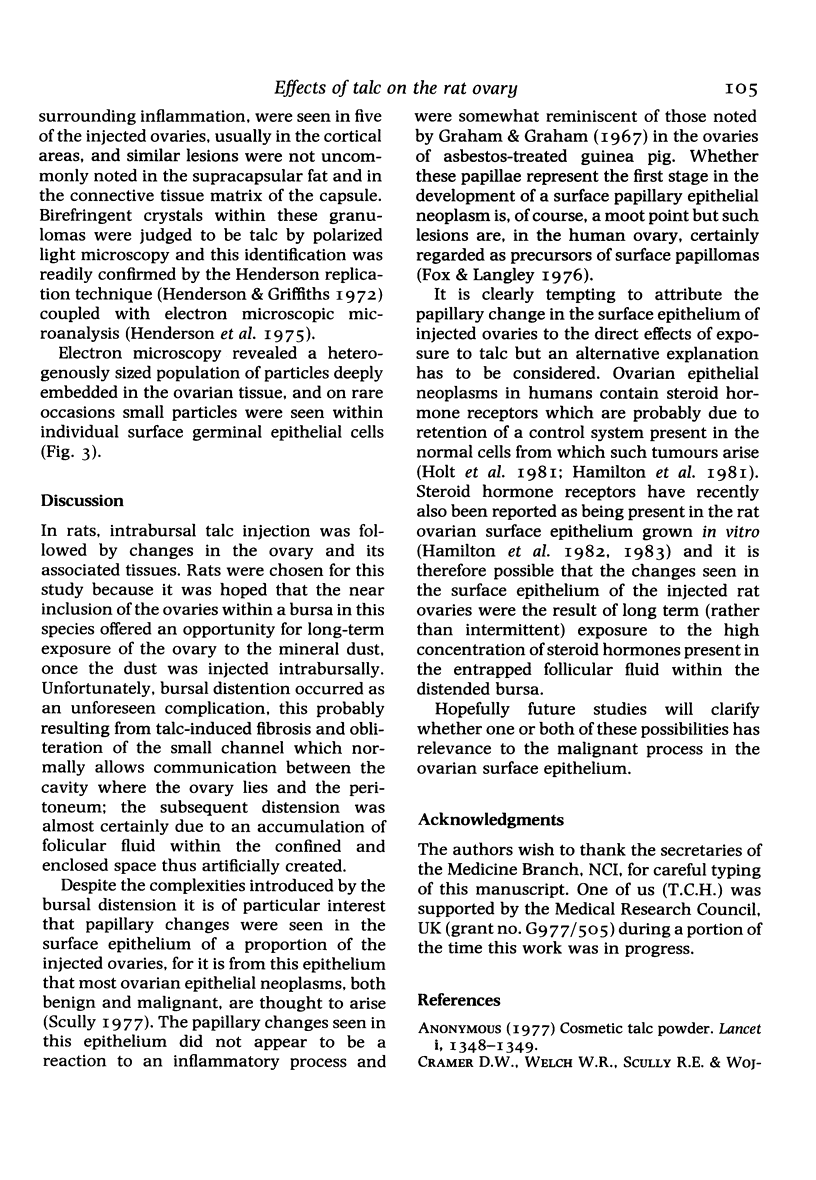Abstract
Exposure of rat ovaries to talc was accomplished by intrabursal injection. As early as 1 and up to 18 months after treatment, the ovaries and associated tissue were cystic in appearance; these changes were the result of bursal distention. Histologically the ovarian tissue was decreased in amount and spread as a remnant on the inner wall of the bursa. In four to 10 treated animals but in no controls, focal areas of papillary change were noted in the surface epithelium of the ovary. Polarized light and electron microscope microanalysis confirmed the presence of talc in the surface epithelium, ovarian cortex, and connective tissue matrix of the bursa. Although the changes in the ovarian surface may be related to direct effects of talc exposure, it is postulated that these changes might also be related to constant exposure to the high concentrations of steroid hormones which have undoubtedly accumulated in the intrabursal space.
Full text
PDF





Images in this article
Selected References
These references are in PubMed. This may not be the complete list of references from this article.
- Hamilton T. C., Davies P., Griffiths K. Oestrogen receptor-like binding in the surface germinal epithelium of the rat ovary. J Endocrinol. 1982 Dec;95(3):377–385. doi: 10.1677/joe.0.0950377. [DOI] [PubMed] [Google Scholar]
- Henderson W. J., Evans D. M., Davies J. D., Griffiths K. Analysis of particles in stomach tumours from Japanese males. Environ Res. 1975 Jun;9(3):240–249. doi: 10.1016/0013-9351(75)90004-3. [DOI] [PubMed] [Google Scholar]
- Henderson W. J., Hamilton T. C., Griffiths K. Talc in normal and malignant ovarian tissue. Lancet. 1979 Mar 3;1(8114):499–499. doi: 10.1016/s0140-6736(79)90860-2. [DOI] [PubMed] [Google Scholar]
- Henderson W. J., Joslin C. A., Turnbull A. C., Griffiths K. Talc and carcinoma of the ovary and cervix. J Obstet Gynaecol Br Commonw. 1971 Mar;78(3):266–272. doi: 10.1111/j.1471-0528.1971.tb00267.x. [DOI] [PubMed] [Google Scholar]
- Katsnelson B. A., Mokronosova K. A. Non-fibrous mineral dusts and malignant tumors: an epidemiological study of mortality. J Occup Med. 1979 Jan;21(1):15–20. [PubMed] [Google Scholar]
- Lingeman C. H. Environmental factors in the etiology of carcinoma of the human ovary: a review. Am J Ind Med. 1983;4(1-2):365–379. [PubMed] [Google Scholar]
- Lingeman C. H. Etiology of cancer of the human ovary: a review. J Natl Cancer Inst. 1974 Dec;53(6):1603–1618. [PubMed] [Google Scholar]
- Roe F. J. Controversy: cosmetic talc and ovarian cancer. Lancet. 1979 Oct 6;2(8145):744–744. doi: 10.1016/s0140-6736(79)90671-8. [DOI] [PubMed] [Google Scholar]





